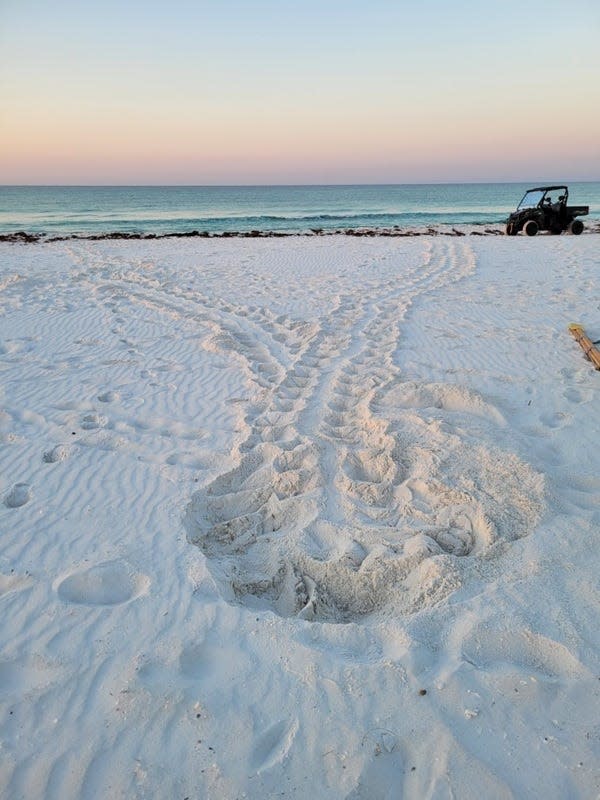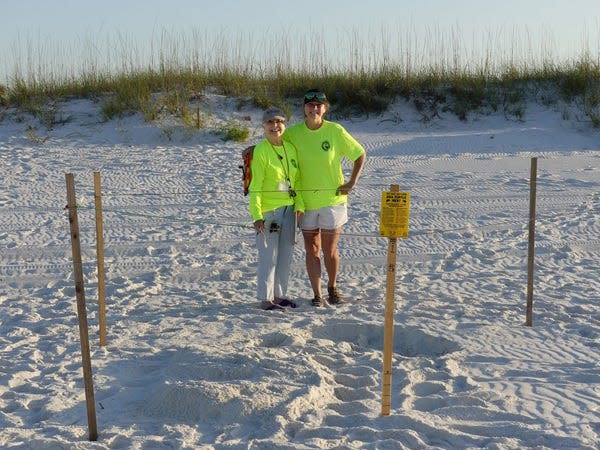After a disastrous 2021, Pensacola sea turtle activists hoping for better nesting season
Editor's note: This story has been updated to identify the sea turtle monitor team that located the turtle nest and clarify the monitor's policies for reorienting misdirected turtles.
Last week, sea turtle monitors Melanie Waite and Connie Bednar spotted the first sea turtle nest of the season.
The first nest was located on the east side of Portofino Island Resort near the dog park May 11, and it was found earlier than any season since 2013.
With the early onset of the season season, patrol partners are hopeful for a better year after a disturbingly unproductive 2021 nesting season, which only saw an 11% hatching success rate. Officials are hoping through education and awareness, the community can help give the hatchlings a better shot at survival this year.

Predicting the success of a season is "really hard to say" due to the unpredictable nature of weather, said Mark Nicholas, marine environmental program manager for Escambia County's Marine Resource Division. Nicholas says Tropical Storms Claudette, Fred and Ida all contributed to the low birth rate last season.
Nicholas works for the Escambia County Sea Turtle Conservation Program, which is "committed to protecting and preserving sea turtles and other marine wildlife." The program is divided into three survey groups: the east and west sections of Perdido Key, and Pensacola Beach.
From 2021: Tropical Storm Claudette erodes loggerhead sea turtle nests in Escambia, Santa Rosa
A sad statistic: More sea turtles hooked by anglers at Navarre Beach Fishing Pier than any pier in Florida
Their responsibilities include locating nests, predicting when the eggs will hatch, checking on the sites and aiding baby sea turtles to the water in appropriate circumstances.
Despite the program's extensive responsibilities, Waite simply said that their focus is to "watch over the sea turtles."
With sea turtle season kicking off, the group has begun to prepare for the various issues that will threaten the turtles.
Waite said the greatest threat to sea turtle nests in Pensacola is the weather, but human interference is also a massive problem.
Every season, sea turtle conservation programs urge beachgoers and businesses to swap bright lights for amber or red lights and to "leave only your footprints."
The Escambia County Sea Turtle Conservation Program is aiding in the campaign against bright lights on the beach by handing out red and amber flashlights at Bands on the Beach, a weekly music festival under the Gulfside Pavilion on Pensacola Beach.
"It's a big commitment," Waite said of safeguarding the turtles.
The volunteers only aid the turtles if they confuse the bright lights of buildings for the reflection of the moon off the ocean. A common occurrence for disoriented adult or hatchling turtles is to venture into roads where they are greeted by speeding cars. If the turtles begin to travel due north instead of south, the volunteers oversee the hatchlings as they reorient them toward the water.
Waite highlighted that while man-made holes are harmful to sea turtles, they are also harmful to the volunteers.
"It's dangerous for us because we're riding out to the beach on four-wheelers looking for turtles that may be stranded or turtle tracks … but then we've got to really focus because there are all these holes that we could fall into," she said.
More from the beach: Turtle lighting and imported sand: What it takes to build on Pensacola's beaches
"If a turtle falls in head first, they can suffocate. A turtle can not crawl backward," Waite said. "If we find them and they weigh 375 pounds, I'm not going be able to get it out of there by myself, I guarantee you."
Any waste, such as trash or chairs, left on the beach can act as an obstruction to the turtle. If a female turtle gets frustrated attempting to maneuver around debris, the turtle could go back to the water and release its eggs into the ocean. Thus, the eggs will never hatch.
Despite the battle against these issues, local attitudes toward conservation are largely positive. Hotels have begun to hand out sea turtle-friendly flashlights and events such as sea turtle baby showers educate the community in fun and engaging ways.

For Bednar, the nest was the first she has identified as a volunteer for the Sea Turtle Monitor Program.
Waite's 30 years of patrol experience allowed her to decipher species of the season's first nesters — loggerheads — from just the "crawl," or their distinctive trail.
Loggerheads — one of seven species of sea turtles — have an "alternating gait" that leaves "wavy," comma-shaped tracks behind them as they venture up the beach to lay their eggs. The species accounts for about 90% of nests laid in Escambia County.
Waite said green turtles produce a parallel track due to their breaststroke-like movements with a "tail drag down the side of it." Kemp's ridley — the most endangered sea turtle species — weighs significantly less than the loggerhead, resulting in footprints as opposed to a deeper trail in the sand. The leatherback leaves a seven-foot-wide and "serpentine" indentation in the ground.
Throughout her extensive career with sea turtles, only two leatherback nests have been found on Pensacola Beach in about two decades and never a hawksbill nest has never been found on Pensacola Beach.
Five of the seven sea turtle species nest in the state of Florida.
Sea turtle season spans from May to October, and eggs usually incubate for about 60 days. Help preserve sea turtles in our community by following these simple guidelines:
Leave no trace. Remove all furniture and toys from the beach when you're done for the day, including hammocks, tents, canopies, chairs, toys and sports equipment.
Lights out. Female turtles prefer dark, quiet beaches for nesting and hatchlings need dark skies to find the Gulf of Mexico. Leave the flashlights and cellphones at home or use a red flashlight when on the beach at night. Turn off beach-facing lights and close windows and curtains to keep our beaches dark.
Stow it, don't throw it. Trash and food waste can entangle turtles and other wildlife and attract unwanted predators. Always dispose of trash in the proper receptacle and refrain from feeding wildlife.
If you dig it, fill it. Large holes are hazardous to both wildlife and people. Avoid digging large holes and fill in any holes, trenches or moats at the end of your visit.
This article originally appeared on Pensacola News Journal: Loggerhead sea turtle nest found on Pensacola Beach near Portofino

